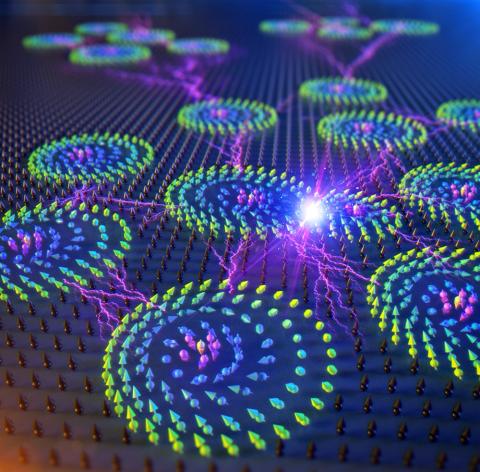
Scientists at the U.S. Department of Energy’s Ames Laboratory have discovered that skyrmions— a type of quasiparticle with properties that could lead to the next generation of data storage and transfer— reproduce by splitting in a way very similar to biological cell division.
Skyrmions are nanoscale magnetic vortices, a type of quasiparticle that are driven by ultra-low electrical current. As a quasiparticle, they have no real mass, yet form a periodic pattern very similar to the symmetrical arrangement of atoms inside a crystal, or crystal lattice.
“In order to integrate skyrmions into future devices, science must have an accurate understanding of their formation mechanism” said Lin Zhou, a scientist who employs cutting-edge microscopy techniques for measuring local magnetic properties in materials at Ames Laboratory’s Sensitive Instrument Facility. “In this research, we directly proved that skyrmion crystal grows from a conical magnetic phase in the same way as real nanocrystals grow from solution.”
Unlike those real crystal structures, however, the skyrmions can annihilate imperfections in the lattice pattern by self-splitting (similar to cell reproduction), a kind of self-healing process that has never been described before.
To understand the physics that control the growth mechanism the team observed, the scientists combined micromagnetic simulation with a string method to investigate the interaction force and transition pathways between various spin states.
“We found that there is a competitive repulsive and attractive interactions force between skyrmions in the cone phase that governs the particle-like skyrmion lattice growth.” said Liqin Ke, a scientist at Ames Laboratory. “And, we found that the self-splitting mechanism is more energetically favorable than nucleation and growth of a new skyrmion inside the defective lattice.”
Zhou said the insight could lead to better control and manipulation of skyrmions, which could help guide the design for high density and energy efficient data storage and transfer devices.
The research is further discussed in the paper, “Mechanisms of Skyrmion and Skyrmion Crystal Formation from the Conical Phase,” authored by Tae-Hoon Kim, Haijun Zhao, Ben Xu, Brandt A. Jensen, Alexander H. King, Matthew J. Kramer, Cewen Nan, Liqin Ke, and Lin Zhou; and published in Nano Letters.
This work is supported in part by Laboratory Directed Research and Development (LDRD) funds through Ames Laboratory and by the U.S. Department of Energy Office of Science.
Ames Laboratory is a U.S. Department of Energy Office of Science National Laboratory operated by Iowa State University. Ames Laboratory creates innovative materials, technologies and energy solutions. We use our expertise, unique capabilities and interdisciplinary collaborations to solve global problems.
Ames Laboratory is supported by the Office of Science of the U.S. Department of Energy. The Office of Science is the single largest supporter of basic research in the physical sciences in the United States, and is working to address some of the most pressing challenges of our time. For more information, please visit https://energy.gov/science.
-30-
Contacts:
Lin Zhou, Division of Materials Sciences and Engineering, 515-294-7590
Laura Millsaps, Ames Laboratory Communications, 515-294-3474
